非谓语动词独立主格
非谓语动词讲解及练习:独立主格结构(Absolutestructure)

非谓语动词讲解及练习:独立主格结构 ( Absolutestructure)1.分词短语作状语时,它的逻辑主语应该是句子的主语。
Eg.) Examining the patient, the doctor wrote down something on paper.Hit by the arrow, he fell from the horse.应避免写分词逻辑主语和句子主语不一致的句子。
如:Walking along the road, an accident happened. (×)Listening to the radio, there was a knock at the door. (×)Walking along the road, I saw an accident. (√)Listening to the radio, I heard a knock at the door. (√)2.但独立主格结构的逻辑主语与句子的主语不是同一个人或事。
独立主格结构--名词普通格或代词主格+其它成分(形,副,介短,分词和不定式)(它们之间存在着逻辑上的主谓关系)独立主格在句子中作状语,可以表示时间、原因、条件和方式、伴随。
主要用于书面语,表示描述.eg.) 1.今天是星期天,你不必去上学。
A) 用原因从句表达:Because it is Sunday, you needn't go to school.B) 用分词独立结构表达:It being Sunday, you needn't go to school.但不能写成:Being Sunday, you needn't go to school.(因分词的逻辑主语不是句子的主语,所以句子错误。
)2.官员们都到齐了,宣布开会。
A) 用分词独立结构表达:All the officials having arrived, the meeting was declared open.B) 用时间状语从句表达:After (when) all the officials had arrived, the meeting wasdeclared open.3. 天气允许的话,我们去颐和园。
非谓语动词的独立主格结构
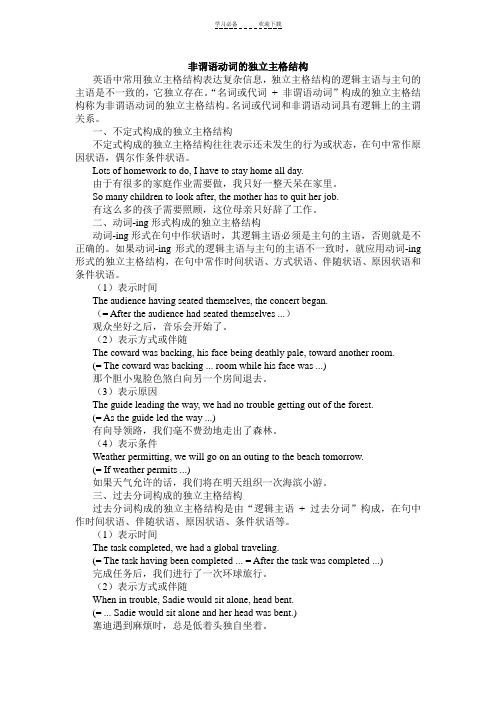
非谓语动词的独立主格结构英语中常用独立主格结构表达复杂信息,独立主格结构的逻辑主语与主句的主语是不一致的,它独立存在。
“名词或代词+ 非谓语动词”构成的独立主格结构称为非谓语动词的独立主格结构。
名词或代词和非谓语动词具有逻辑上的主谓关系。
一、不定式构成的独立主格结构不定式构成的独立主格结构往往表示还未发生的行为或状态,在句中常作原因状语,偶尔作条件状语。
Lots of homework to do, I have to stay home all day.由于有很多的家庭作业需要做,我只好一整天呆在家里。
So many children to look after, the mother has to quit her job.有这么多的孩子需要照顾,这位母亲只好辞了工作。
二、动词-ing形式构成的独立主格结构动词-ing形式在句中作状语时,其逻辑主语必须是主句的主语,否则就是不正确的。
如果动词-ing形式的逻辑主语与主句的主语不一致时,就应用动词-ing 形式的独立主格结构,在句中常作时间状语、方式状语、伴随状语、原因状语和条件状语。
(1)表示时间The audience having seated themselves, the concert began.(= After the audience had seated themselves ...)观众坐好之后,音乐会开始了。
(2)表示方式或伴随The coward was backing, his face being deathly pale, toward another room.(= The coward was backing ... room while his face was ...)那个胆小鬼脸色煞白向另一个房间退去。
(3)表示原因The guide leading the way, we had no trouble getting out of the forest.(= As the guide led the way ...)有向导领路,我们毫不费劲地走出了森林。
独立主格结构和非谓语动词的区别
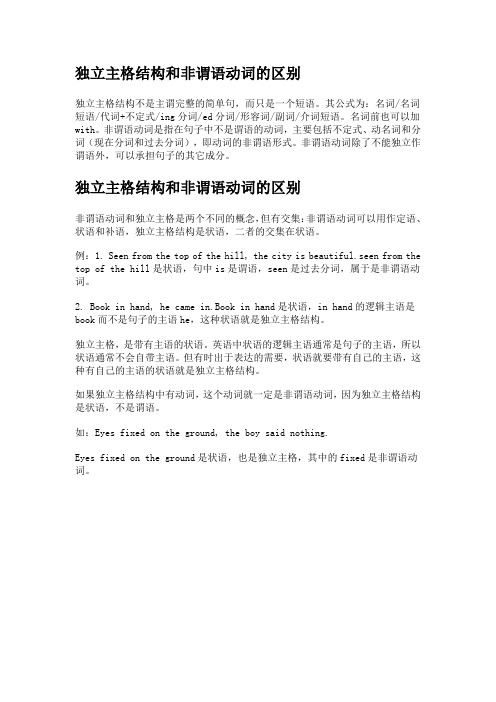
独立主格结构和非谓语动词的区别
独立主格结构不是主谓完整的简单句,而只是一个短语。
其公式为:名词/名词短语/代词+不定式/ing分词/ed分词/形容词/副词/介词短语。
名词前也可以加with。
非谓语动词是指在句子中不是谓语的动词,主要包括不定式、动名词和分词(现在分词和过去分词),即动词的非谓语形式。
非谓语动词除了不能独立作谓语外,可以承担句子的其它成分。
独立主格结构和非谓语动词的区别
非谓语动词和独立主格是两个不同的概念,但有交集:非谓语动词可以用作定语、状语和补语,独立主格结构是状语,二者的交集在状语。
例:1. Seen from the top of the hill, the city is beautiful.seen from the top of the hill是状语,句中is是谓语,seen是过去分词,属于是非谓语动词。
2. Book in hand, he came in.Book in hand是状语,in hand的逻辑主语是book而不是句子的主语he,这种状语就是独立主格结构。
独立主格,是带有主语的状语。
英语中状语的逻辑主语通常是句子的主语,所以状语通常不会自带主语。
但有时出于表达的需要,状语就要带有自己的主语,这种有自己的主语的状语就是独立主格结构。
如果独立主格结构中有动词,这个动词就一定是非谓语动词,因为独立主格结构是状语,不是谓语。
如:Eyes fixed on the ground, the boy said nothing.
Eyes fixed on the ground是状语,也是独立主格,其中的fixed是非谓语动词。
非谓语动词独立主格知识点讲义2023届高考英语复习

非谓语动词独立主格非谓语动词作状语时,它的逻辑主语应该和句子主语保持一致。
但是有时非谓语动词带有自己的逻辑主语,在句子中做状语,我们称之为独立主格。
它的结构特点是:①独立主格中的状语有自己独立的主语,与主句的主语不同,前后主语不一致;②在独立主格中的状语中,不定式表示还未作,过去分词表示被动;现在分词表示主动③独立主格结构一般都有逗号与主句分开。
独立主格的结构为:(with)主语+V+ing/v+ed/ to do sth/ adj/ 介词结构/ 副词1). 名词/主格代词+现在分词。
名词/主格代词与现在分词之间主谓关系。
如:The girl staring at him (= as the girl stared at him), he didn’t know what to say.= With the girl staring at him, he didn’t know what to say.姑娘两眼望着他,他不知道说什么好。
Time permitting (= if time permits), we will go for an outing tomorrow.= _______________________________________________________如果时间允许的话,我们明天去郊游。
2). 名词/主格代词+过去分词。
名词/主格代词与过去分词之间的动宾关系。
如:The problems solved (= as the problems were solved), the quality has been improved.= With the problem solved, the quality has been improved.随着问题的解决,质量已经提高了。
Her glasses broken (= because her glasses were broken), she couldn’t see the words on the blackboard. =__________________________________________________________________. 由于眼镜摔坏了,她看不见黑板上的字。
非谓语动词与独立主格

(一)动词不定式:(to)+do,具有名词、形容词、副词的特征.否定式:not + (to) do(1)一般式:不定式的一般式所表示的动作与谓语动词动作同时发生或发生在谓语动词动作之后.例如:I'm glad to meet you.He seems to know a lot.We plan to pay a visit.He wants to be an artist.The patient asked to be operated on at once.The teacher ordered the work to be done.(2)进行式:不定式的进行式所表示的动作与谓语动词动作同时发生,例如:The boy pretended to be working hard.He seems to be reading in his room.(3)完成式:不定式的完成式表示的动作发生在谓语动词动作之前,例如:I regretted to have told a lie.I happened to have seen the film.He is pleased to have met his friend.2.不定式的句法功能:(1)作主语:To finish the work in ten minutes is very hard.To lose your heart means failure.动词不定式短语作主语时,常用it作形式主语,真正的主语不定式置于句后,例如上面两句可用如下形式:It is very hard to finish the work in ten minutes.It means failure to lose your heart.常用句式有:1、It+be+名词+to do。
2、It takes sb.+some time+to do。
3、It+be+形容词+of sb +to do。
非谓语动词与独立主格结构

非谓语动词与独立主格结构非谓语动词分为三类:不定式(infinitive)、动名词(gerund)与分词(participle)。
其特点就是:1.不定式、动名词与分词可以做很多句子成分,但就就是不能单独做谓语,这也就是它们被称为"非谓语动词"得原因。
2.它们具有各种形态:一般式、主动态、被动态、进行态与完成态。
3.不定式与动名词可以做主语、宾语、表语、补语等。
但不管起什么作用,它们都具有动词得功能,但无语法上得动词性质,这一点可以通过它们不受主语得人称与数得限制体现出来。
4.分词起形容词与副词作用,可做表语、定语、状语,但不能做主语与宾语。
它也不受主语人称与数得限制。
一.不定式1、完成式不定式得一般形式所表示得动作, 通常与主要谓语表示得动作(状态)同时(或几乎同时)发生, 或就是在它之后发生、假如不定式所表示得动作, 在谓语所表示得动作(状态)之前发生, 就要用不定式得完成式、I am glad to have seen your mother (= I am glad I have seen your mother)、(比较: I am glad to see you、)He is said to have written a new book about workers、He pretended not to have seen me、2、进行式如果主要谓语表示得动作(状态)发生时, 不定式表示得动作正在进行, 这时要用不定式得进行式、You are not supposed to be working、You haven’t quite recovered yet、We didn’t expect you to be waiting for us here、He pretended to be listening attentively、3、完成进行式在谓语所表示得时间之前一直进行得动作, 就要用不定式得完成进行式、The struggle was known to have been going for twenty years、We are happy to have been working with you、4、被动式当不定式得逻辑上得主语就是不定式所表示得动作得承受者时, 不定式一般要用被动形式、It is an honor for me to be asked to speak here、She hated to be flattered、He wanted the letter to be typed at once、【例】Sir Denis, who is 78, has made it known that much of his collection ______ to the nation、A) has left B) is to leave C) leaves D) is to be left结合选项来瞧,全句得意思:“78岁得丹尼斯爵士已经向众人宣布她得许多收藏品将留给国家"。
独立主格结构和非谓语动词的形式
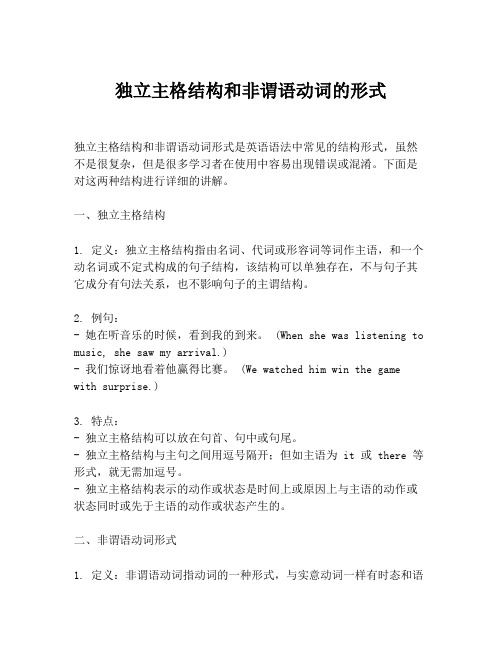
独立主格结构和非谓语动词的形式独立主格结构和非谓语动词形式是英语语法中常见的结构形式,虽然不是很复杂,但是很多学习者在使用中容易出现错误或混淆。
下面是对这两种结构进行详细的讲解。
一、独立主格结构1. 定义:独立主格结构指由名词、代词或形容词等词作主语,和一个动名词或不定式构成的句子结构,该结构可以单独存在,不与句子其它成分有句法关系,也不影响句子的主谓结构。
2. 例句:- 她在听音乐的时候,看到我的到来。
(When she was listening to music, she saw my arrival.)- 我们惊讶地看着他赢得比赛。
(We watched him win the game with surprise.)3. 特点:- 独立主格结构可以放在句首、句中或句尾。
- 独立主格结构与主句之间用逗号隔开;但如主语为 it 或 there 等形式,就无需加逗号。
- 独立主格结构表示的动作或状态是时间上或原因上与主语的动作或状态同时或先于主语的动作或状态产生的。
二、非谓语动词形式1. 定义:非谓语动词指动词的一种形式,与实意动词一样有时态和语态之分,但不具有主谓关系的特征,可以作名词、形容词、副词的修饰语或状语。
2. 例句:- 他很喜欢跑步。
(He likes running very much.)- 我已经看过这本小说。
(I have read this novel.)3. 特点:- 非谓语动词可以表示动作或状态,包括不定式、动名词和分词。
- 不定式用于表示未完成的动作或目的,常用 to + 动词原形的形式。
- 动名词常常与进行时态连用,常用动词 + ing 的形式。
- 分词可作形容词使用,分现在分词和过去分词两种形式,有状语和定语的双重作用。
总之,在使用独立主格结构和非谓语动词形式时,需要注意它们所代表的中心意思和句子结构的要求。
正确使用这两种结构形式会让英语表达更加丰富和具有表现力。
(完整版)非谓语动词和独立主格
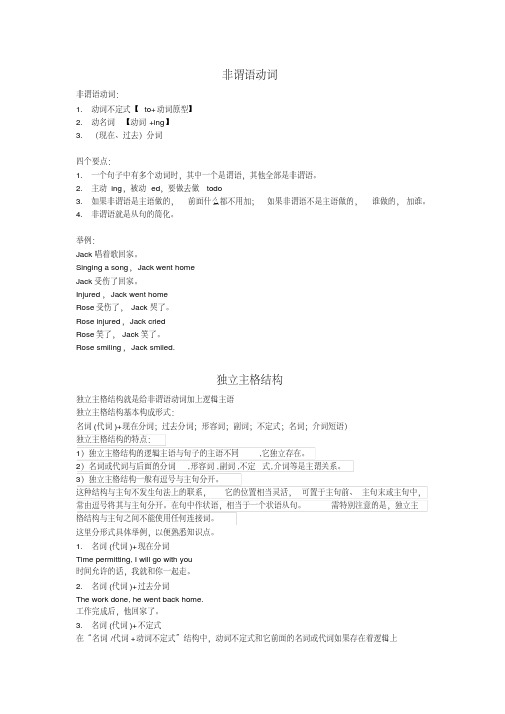
非谓语动词非谓语动词:1.动词不定式【to+动词原型】2.动名词【动词+ing】3.(现在、过去)分词四个要点:1.一个句子中有多个动词时,其中一个是谓语,其他全部是非谓语。
2.主动ing,被动ed,要做去做todo3.如果非谓语是主语做的,前面什么都不用加;如果非谓语不是主语做的,谁做的,加谁。
4.非谓语就是从句的简化。
举例:Jack唱着歌回家。
Singing a song,Jack went homeJack受伤了回家。
Injured,Jack went homeRose受伤了,Jack哭了。
Rose injured,Jack criedRose笑了,Jack笑了。
Rose smiling,Jack smiled.独立主格结构独立主格结构就是给非谓语动词加上逻辑主语独立主格结构基本构成形式:名词(代词)+现在分词;过去分词;形容词;副词;不定式;名词;介词短语)独立主格结构的特点:1)独立主格结构的逻辑主语与句子的主语不同,它独立存在。
2)名词或代词与后面的分词,形容词,副词,不定式,介词等是主谓关系。
3)独立主格结构一般有逗号与主句分开。
这种结构与主句不发生句法上的联系,它的位置相当灵活,可置于主句前、主句末或主句中,常由逗号将其与主句分开。
在句中作状语,相当于一个状语从句。
需特别注意的是,独立主格结构与主句之间不能使用任何连接词。
这里分形式具体举例,以便熟悉知识点。
1.名词(代词)+现在分词Time permitting, I will go with you时间允许的话,我就和你一起走。
2.名词(代词)+过去分词The work done, he went back home.工作完成后,他回家了。
3.名词(代词)+不定式在“名词/代词+动词不定式”结构中,动词不定式和它前面的名词或代词如果存在着逻辑上的主谓关系,动词不定式则用主动的形式;如果是动宾关系,则用被动形式。
Many trees, flowers, and grass to be planted, our school will look even more beautiful.种上许多的树、花和草后,我们新建的学校看上去将更美。
非谓语动词与独立主格结构
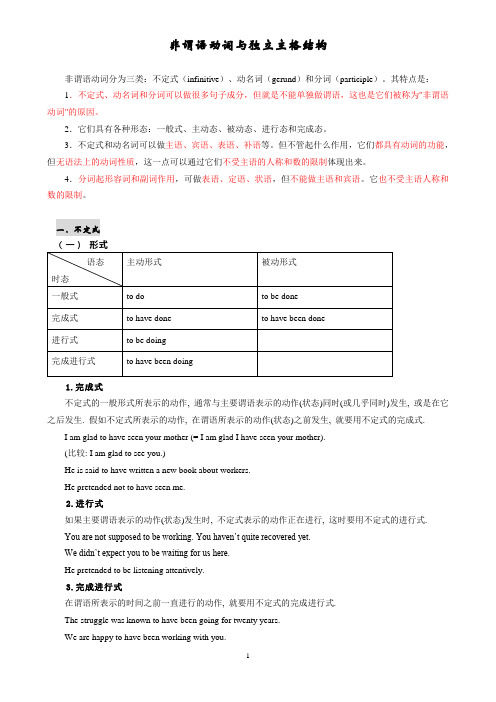
非谓语动词与独立主格结构非谓语动词分为三类:不定式(infinitive)、动名词(gerund)和分词(participle)。
其特点是:1.不定式、动名词和分词可以做很多句子成分,但就是不能单独做谓语,这也是它们被称为"非谓语动词"的原因。
2.它们具有各种形态:一般式、主动态、被动态、进行态和完成态。
3.不定式和动名词可以做主语、宾语、表语、补语等。
但不管起什么作用,它们都具有动词的功能,但无语法上的动词性质,这一点可以通过它们不受主语的人称和数的限制体现出来。
4.分词起形容词和副词作用,可做表语、定语、状语,但不能做主语和宾语。
它也不受主语人称和数的限制。
一.不定式1.完成式不定式的一般形式所表示的动作, 通常与主要谓语表示的动作(状态)同时(或几乎同时)发生, 或是在它之后发生. 假如不定式所表示的动作, 在谓语所表示的动作(状态)之前发生, 就要用不定式的完成式.I am glad to have seen your mother (= I am glad I have seen your mother).(比较: I am glad to see you.)He is said to have written a new book about workers.He pretended not to have seen me.2.进行式如果主要谓语表示的动作(状态)发生时, 不定式表示的动作正在进行, 这时要用不定式的进行式.You are not supposed to be working. You haven’t quite recovered yet.We didn’t expect you to be waiting for us here.He pretended to be listening attentively.3.完成进行式在谓语所表示的时间之前一直进行的动作, 就要用不定式的完成进行式.The struggle was known to have been going for twenty years.We are happy to have been working with you.4.被动式当不定式的逻辑上的主语是不定式所表示的动作的承受者时, 不定式一般要用被动形式.It is an honor for me to be asked to speak here.She hated to be flattered.He wanted the letter to be typed at once.【例】1) Sir Denis, who is 78, has made it known that much of his collection ______ to the nation.A) has left B) is to leave C) leaves D) is to be left结合选项来看,全句的意思:“78岁的丹尼斯爵士已经向众人宣布他的许多收藏品将留给国家"。
非谓语动词之独立主格结构

非谓语动词之独立主格结构独立主格结构(The Absolute Structure)指由逻辑主语+逻辑谓语构成的结构,独立于句子之外,并在句子中作状语、定语等成分的结构。
1.构成独立主格结构主要有两种形式,一种是非谓语动词构成的独立主格结构,一种是名词/代词+其他词类构成的独立主格结构。
(1)非谓语动词构成的独立主格结构非谓语动词在句中作状语时,其逻辑主语必须与主句一致,但有时其逻辑主语不是主句的主语,此时应在其前加上其逻辑主语,所以“逻辑主语+动词-ing”、“逻辑主语+动词-ed”、“逻辑主语+不定式”便构成了非谓语形式的独立主格结构。
独立主格结构在句中主要作状语,更多地用于书面语中。
Leaves falling here and there , I suddenly notice autumn is drawing upon.(Leaves是falling的逻辑主语,独立主格结构在句中作原因状语。
)The boy was knocked over , blood streaming down his head .(blood是streaming的逻辑主语,独立主格结构在句中作结果状语。
)The plan successfully carried out , everything worked out perfectly . (the plan是carried out的逻辑主语,独立主格结构在句中作原因状语。
)Lost of homework to do , I have to stay home all day . (名词+不定式)(2)名词/代词+其他词类构成的独立主格结构名词/代词+名词、名词/代词+形容词、名词/代词+副词、名词/代词+介词短语也可构成独立主格结构。
Many people attended the conference , most of them experts from the States.(代词+名词)She was sitting at the table , head in her hands . (名词+介词短语)All the windows open , the air in the room is fresher .(名词+形容词)The football game over , the streets were soon crowded with the spectators .(名词+副词)2.独立主格结构的用法独立主格结构一般作状语,有的特殊形式可作定语。
非谓语动词—独立主格结构

非谓语动词--独立主格结构独立主格的“独立结构”独立主格结构在书面语中一般用来替代从句,以使语言简练,在句中一般作状语或定语。
独立主格结构不是句子,因此其中不能出现谓语动词,而只能出现非谓语动词。
独立主格结构的基本结构:1.名词/代词+形容词2.名词/代词+副词3.名词/代词+介词短语4.名词/代词+非谓语动词(现在分词、过去分词、不定式)5.“with+名词/代词/形容词/副词/介词短语/非谓语动词”是一种特殊的独立主格结构,可以在句中作定语或状语。
【渐入佳境】1.The living room is clean and tidy, with a dining table already_____for a meal to be cooked.A. laidB. layingC. to layD. being laid2. The boys were happily making a snowman, ______with cold.A. their faces redB. their faces were redC. their faces turned redD. their faces to be red3. He was so tired that he fell asleep quickly, the light over his bed_______.A. burnB. went onC. lightedD. on4. He ran after the dog, ________.A. stick in his handB. stick in handC. a stick in his handD. having a stick in hand5.—Wow! It snowed last night. What a nice world!--Y ou’re right. But it’s more difficult to find my missing keys with snow______the ground.A. coveredB. coverC. to coverD. covering6. John received an invitation to dinner, and with his work_____, he gladly accepted it.A. finishedB. finishingC. having finishedD. was finished7.______from the room, our earth with water________seventy percent of its surface, appears a blue ball.A. Seen; coveredB. Seen; coveringC. To see; coveringD. Seeing; covering8. The saleswoman with her lips still_______couldn’t say a word, _____at the boring customer.A. trembling; staringB. trembling; staredC. trembled; staringD. trembled; to stare9. With an important meeting______at noon, he decided not to go home for lunch.A. attendedB. attendingC. to attendD. to be attended10. Mr. Smith has three children, the youngest of them_______music at college.A. is studyingB. studiesC. studyingD. studied11. With most of the problem_______, I felt a great weight taken off my mind.A. to solveB. solvedC. solvingD. being solved1。
非谓语动词独立主格结构

独立主格结构。
非谓语动词作状语时,它的逻辑主语应该是句子的主语。
但有时非谓语动词带有自己的主语,从而在结构上与主语不发生关系,我们称之为独立主格结构(Absolute Construction)。
其实,所谓“独立主格结构”也并非真正独立,它还是一种从属的结构。
非谓语动词独立主格结构在独立主格结构中,非谓语动词和它前面的名词或代词存在着逻辑上的主谓关系。
Such an able man to help you,you will surely succeed sooner or later.有这么能干的人来帮你,你迟早一定会成功的。
(such an able man 和to help you之间存在着主谓关系)= Since such an able man will help you, you will surely succeed sooner or later.He seating himself at the desk, his mother began to tell him a story.他在书桌旁坐好后,他母亲开始给他讲故事。
(seating himself at the desk拥有了自己的逻辑主语he,注意是"主格")= When he seated himself at the desk, his mother began to tell him a story.The key to the bike lost, he had to walk to school.由于丢了自行车钥匙,他只好步行去学校。
(lost的逻辑主语是the key,lost也可以用完成式having been lost)= Because the key to the bike had been lost, he had to walk to school.。
独立主格结构和非谓语动词

独立主格结构和非谓语动词一、独立主格结构(1)独立主格结构是一种短语,而不是句子。
它有自己的主语,所以相对独立。
我们将其主语称为小主语,将主句的主语称为大主语,小主语和大主语是不相同的。
独立主格结构包括含有with的独立结构结构和不含有with的独立主格结构。
With独立主格结构主要做状语,偶尔作后置定语。
不含有with的独立主格结构主要做状语。
(2)独立主格结构的基本形式有:(with)+小主语+现在分词(doing):表示主动(with)+小主语+过去分词(done):表示被动和完成(with)+小主语+不定式(to do):表示将要被做,没有被动形式(with)+小主语+形容词/副词/介词短语/名词:表示状态(3)独立主格结构的作用:独立主格结构在主句之前做原因或者时间状语,在主句之后做伴随状语。
With独立主格结构偶尔做后置定语。
(4)独立主格结构、从句、主句、分词短语之间的关系:如果一个原因或者时间状从的主语与主句的主语相同,可以将该从句转化为分词短语;如果一个原因或者时间状从的主语与主句的主语不相同,可以将该从句转化为独立主格结构;(5)特殊的独立主格结构:There being many strangers there(表原因), he hesitated to speak.It being a fine day(表原因), let’s have an outing.二、非谓语动词谓语动词就是不能做谓语的动词形式,包括现在分词(doing)、过去分词(done)、动名词(doing)和动词不定式(to do)。
非谓语动词要和系动词(be, become, get, grow, turn等)、助动词(be, have, do)、情态动词(can, may, must, will, shall等)一起构成谓语部分,表示时态等。
独立主格结构和非谓语动词总结

独立主格结构和非谓语动词游航Teaching aims:a)了解独立主格结构和非谓语动词的区别及联系b)掌握独立主格结构的形式和用法c)掌握非谓语动词(to do, doing, done)的用法Language points:a) New Vocabulary: No formal focusb) New Structure:①with/ without/ like +n/pron + prep②n + to do/ doing/ done/ adj.Teaching Procedure:Stage 1, 独立主格结构:独立主格结构,顾名思义,指独立于主句之外的结构,用于修饰整个句子,相当于状语,可以用于表示时间、原因、条件,也可描述伴随的状态或起补充说明的作用,但不和主句发生句法上的联系,位置灵活(句首,句末,句中),常用逗号将其与主句隔开,主要有以下种构成:a) prep+复合宾语,即with/ without/ like + n/pron主格+ 非谓语动词/ adj/adv/ 介词短语(可以省略with/ without)The cleverest housewife can’t cook a meal without rice.巧妇难为无米之炊No smoke without fire.无风不起浪.The teacher entered the classroom, with a book in his hand.I can’t go out with you, with a lot of homework to do.Xiao Li can’t pass the final exam, without you helping him.The girl hid her box without anyone knowing where it was.Without a word spoken, she committed suicide.The boy was walking, with his father ahead.With his son so clever, the old man felt very proud of him.b) n/ pron(主格) + doing/ to do/ done (非谓语动词)eg: Spring coming on, the trees turned green.It being Sunday, children had no classes.The teacher to help us, we will succeed.All things considered, her suggestion is of greater value than yours.He sat silently, eyes closed.c) n/ pron(主格) + adj/ adveg: Everything ready, they started out. (也可用Everything being ready,…) The meeting over, the students were dismissed.Computers very small, we can use them widely.The lights off, we could not go on with the work.d) n/ pron(主格) + 介词短语eg: The old man sat in the chair, book in hand and pipe in mouth.非谓语动词:1._______, you must be well-prepared for the interview.A. Getting this jobB. To get this jobC. having gotten this jobD. have the job gotten2._______ the final exam, Mary studies day and night.A. To passB. PassingC. PassedD. Past3.Their wedding, _________ next week, will be very ceremoniously, with lots ofcelebrities ______ here.A. be held, comingB. to be held, comingC. holding, to comeD. to be held, to come4.“We can’t go out in this weather,” said Bob, ______out of the window.A. lookingB. lookC. to lookD. looked5.The old man, ______ abroad for twenty years, is on the way back to hismotherland.A. to workB. workingC. to have workedD. having worked6. _______ the programme, they have to stay there for another two weeks.A. Not completingB. Not completedC. Not having completedD. Having not completed7. ________ by the beauty of nature, the girl decided to stay another two days on the seaside.A. AttractingB. AttractedC. To be attractedD. Having attracted8. Linda worked for the Minnesota Manufacturing and Mining Company, ________ as 3M.A. KnowingB. being knownC. knownD. to be known9. ________with the size of the whole earth, the biggest ocean doesn’t seem big at all.A. CompareB. When comparingC. ComparingD. When compared Stage 2, 非谓语动词—不定式(to do)动词不定式(to do)具有n, adj, adv 的特征,它在句中可以作主语、宾语、表语、定语和状语。
独立主格和非谓语动词的用法和练习
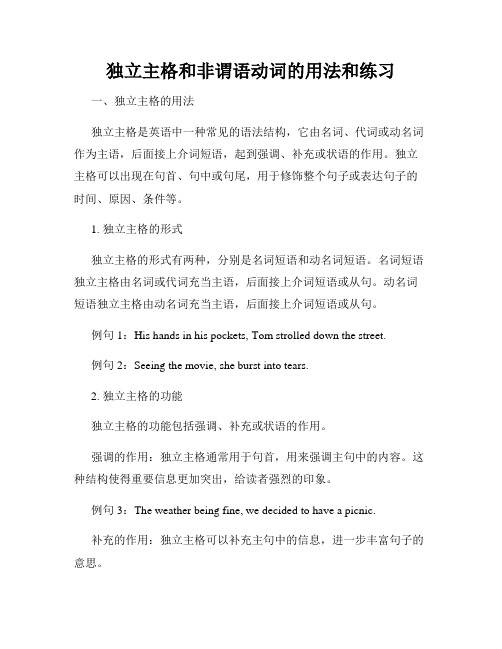
独立主格和非谓语动词的用法和练习一、独立主格的用法独立主格是英语中一种常见的语法结构,它由名词、代词或动名词作为主语,后面接上介词短语,起到强调、补充或状语的作用。
独立主格可以出现在句首、句中或句尾,用于修饰整个句子或表达句子的时间、原因、条件等。
1. 独立主格的形式独立主格的形式有两种,分别是名词短语和动名词短语。
名词短语独立主格由名词或代词充当主语,后面接上介词短语或从句。
动名词短语独立主格由动名词充当主语,后面接上介词短语或从句。
例句1:His hands in his pockets, Tom strolled down the street.例句2:Seeing the movie, she burst into tears.2. 独立主格的功能独立主格的功能包括强调、补充或状语的作用。
强调的作用:独立主格通常用于句首,用来强调主句中的内容。
这种结构使得重要信息更加突出,给读者强烈的印象。
例句3:The weather being fine, we decided to have a picnic.补充的作用:独立主格可以补充主句中的信息,进一步丰富句子的意思。
例句4:The test over, the students left the classroom.状语的作用:独立主格可以用来表示时间、原因、条件等,在句子中起到修饰或状语的作用。
例句5:The door being locked, we had to find another way in.二、非谓语动词的用法非谓语动词指的是不带有动词个人形态的动词形式。
在英语中,非谓语动词主要有动词不定式、动名词和分词三种形式,具有名词、形容词或副词的特点。
1. 动词不定式动词不定式是非谓语动词的一种形式,一般由"to + 动词原形"组成。
动词不定式可以作为句子的主语、宾语、表语、定语、状语等。
主语:例句6:To learn a foreign language is not easy.宾语:例句7:She wants to visit her grandparents next week.表语:例句8:The most important thing is to believe in yourself.定语:例句9:I have a book to read tonight.状语:例句10:He left the office to catch the last train.2. 动名词动名词是以动词加-ing形式构成的名词,具有名词的性质。
非谓语动词在独立主格结构和易错用法

六、非谓语动词在独立主格中的应用谓语动词不能用于独立主格结构,而非谓语动词则可以。
非谓语动词作状语,如果不是特殊情况,其逻辑主语就是句子的主语,如果不是,就必须另加一个逻辑主语。
这种逻辑主语加逻辑谓语的结构就形成了独立主格结构。
总体来讲,“逻辑主语+逻辑谓语”构成独立主格结构。
注意,如果逻辑谓语是联系动词,还要跟逻辑表语;如果是及物动词,还要跟宾语。
另外,独立主格结构中的非谓语动词being和having been通常被省略。
但是,当强调非谓语动词的动作早于谓语动作时,having been不能省略。
独立主格结构在句中常作状语,表示时间,条件,原因,伴随或起补充说明的作用。
请看以下独立主格结构的四种句型:⑴逻辑主语+being/having been+逻辑表语(形容词、副词、名词、介词短语)being是一种联系动词的形式,表示逻辑主语现在或当时的性质或状态。
若把独立主格结构变成状语从句,从句中的谓语用一般时态。
这时,只要不是在there being句型当中,being常被省略。
如果不省略,要么是为了强调,要么是为了读起来顺口;having been表示逻辑主语早于谓语动作的性质或状态。
若把独立主格结构变成状语从句,从句中的谓语用完成时态。
这时,having been不能省略。
例如:He entered the room, his nose (being) red with cold.他进入了房间,鼻子冻得发红。
(伴随状语,=and his nose was red with cold)They went out of the room, the light (being) out.他们走出了房间,灯随之灭了。
(伴随状语,=and the light was out)The meeting being over, they went to the zoo.会议结束了,他们向动物园走去。
(时间状语,=when the meeting was over)She came up, her hair (being) a wreck.她走了进来,头发蓬乱不堪。
非谓语动词的独立主格结构

非谓语动词的独立主格结构非谓语动词的独立主格结构,听起来有点拗口,但其实用起来可简单得多,轻松得很。
就像你在咖啡馆里,点了一杯拿铁,顺便跟朋友聊聊那些“脱离正轨”的小故事。
哎,别看这结构复杂,实际上它就像你身边那个总能给你带来惊喜的朋友,总能在你意想不到的时候,给你一阵爽快。
想象一下,你在公园里散步,阳光明媚,鸟儿在树上唱着小曲,突然看到一只小狗在追逐自己的尾巴。
真是好笑,狗狗摇摇晃晃,满脸疑惑,似乎在想:“这东西怎么就抓不住呢?”此时,如果我们用独立主格结构来描述,就能把这个场景生动地表现出来。
比如说,“小狗追着自己的尾巴,搞得一头雾水。
”这样一来,读者不仅能感受到小狗的可爱,还能从中品味到一种幽默的气息。
再说说旅行吧,想象你和一群朋友一起背包游。
大清早,大家都还在梦乡,只有你一人早起,喝着咖啡,静静地看着窗外的风景。
此时你可以说:“我坐在那里,望着窗外的美景,心里美滋滋的。
”简单的一句话,瞬间就把那种悠闲的感觉传达出来。
旅行的乐趣就在于发现和享受那些小确幸,而独立主格结构恰好能够把这种情感表达得淋漓尽致。
说到吃,哎呀,我最喜欢了。
想象一下,周末聚餐,桌子上摆满了丰盛的菜肴。
大口吃肉,大口喝酒,大家的笑声回荡在空气中,真是美好极了。
你可以这样描述:“我们一边吃着美味的火锅,一边聊着生活的琐事,笑声此起彼伏。
”这样一来,仿佛那一刻的欢乐都跃然纸上,让人不禁想加入其中。
生活中总有一些烦心事。
比如说,早上起不来,匆匆忙忙赶去上班,路上还遇到堵车。
心里那个火啊,真是恨不得变成一阵风,呼啸而过。
这时候你可以说:“我在车里坐得快要发疯,心里想着该怎么跟老板解释迟到的理由。
”这种夸张的说法,既反映了你的无奈,又让人会心一笑。
说到朋友,咱们总有那么几个死党。
无论何时何地,只要聚在一起,就像回到了无忧无虑的少年时代。
比如说,大家一起去KTV,唱得那叫一个尽兴,结果一个朋友突然走音,大家笑得前仰后合。
这时候,独立主格结构又派上用场:“我们在KTV里唱得正欢,突然他走音,大家笑得肚子疼。
- 1、下载文档前请自行甄别文档内容的完整性,平台不提供额外的编辑、内容补充、找答案等附加服务。
- 2、"仅部分预览"的文档,不可在线预览部分如存在完整性等问题,可反馈申请退款(可完整预览的文档不适用该条件!)。
- 3、如文档侵犯您的权益,请联系客服反馈,我们会尽快为您处理(人工客服工作时间:9:00-18:30)。
Such being the case, she has nothing to say. Such being the fact, she had to admit his mistake.
• I have never imagined of there being a picture on the wall.
要求:不适用连词,将两个句子 合并为一个句子。
☞ It raining, I stayed at home.
比较三句:
☞ It rain so/and I stayed at home.
☞ Because it rained yesterday, I stayed at home.
☞ It raining, I stayed at home.
特殊:
As there was no bus, we had to go back
home on foot. _T_h_e_re__b_e_in__g_n_o__b_u_s_, we had to go back home on foot.
Because it is Sunday today, we don’t have to work. __It_b__e_in_g__S_u_n_d_a_y___, we don’t have to work.
并列连词:and, or, but, so, for, when, while, neither…nor,
either…or, not…but, not only…but also
要求:可以使用连词,请将 句子合并为复合句。
☞ Because it rained yesterday, I stayed at home.
off. When the meeting was over, we left the room. __T_h_e_m__e_e_ti_n_g__o_v_e_r_____, we left the room.
She stood there, a book in his hand. = book in hand
• I send you 100 dollars today, and the rest will follow in a year.
• I send you 100 dollars today, __th_e__r_e_s_t _to__fo__ll_o_w_____in a year.
2.名词/主格代词+(being)+adj./adv./介词短语/n As the teacher was ill, the lecture was put off. __T_h_e_t_e_a_c_h_e_r__il_l _____, the lecture was put
clenched on his breast and his glaring eyes looking straight upward.
名词或代词+不定式 1)明天要考试,我今晚就不去看电影了吧。
The exam to be held tomorrow, I couldn’t go to the cinema tonight.
• I expect there to be many chances for him to get a job.
• What is the chance of there ____ some good dictionaries in that bookstore?
• The teacher was waiting for there___ complete silence.
主语是代词时,being不能省
区别于分词作状语
分词做状语特点: • 现在分词作状语,表主动的动作,或表动
作正在进行
• 过去分词作状语,表被动的动作,或表动 作已经完成。
分词作状语
1 When they hear the news, they all jumped with joy
Hearing the news, they all jumped with joy.
2 When it is seen from the hill, the park looks very beautiful.
Seen from the hill, the park looks very beautiful.
3 The children ran out of the room. They laughed and talked merrily.
⑧ He reached the beautiful river with red flowers and green trees on both sides. 他来到了两岸长满红花绿树的这条河上。(作后置定 语,修饰river)
★ 独立主格结构
permitting Father ________(permit), Grace enjoyed a big bonbon. The game __l_o_s_t___(lose), Grace still looked up to her
⑥ He fought the tiger without a stick as his only weapon. 他与老虎搏斗, 没有一根棍子作为武器。(表示方式)
⑦ The teacher entered the classroom, with a book in his hand. 老师进入了教室,手里拿着一本书。(表伴随状况)
区别于介词with / without复合结 构
With / without + 名词/宾格代词
doing(表示动作的主动和进行) done(表示动作的被动和完成)
+ to do(表示将来) adj / adv (表示状态或特征) 介词短语(表示状态或特征)
该结构作状语可以表示时间、原因、方式、伴随状况等 含义;有时候也可以作定语。
Nobody having any more to say, the meeting was closed.
It rained. I stayed at home.
怎样将两个句子合并?
要求:可以使用连词,请将句 子合并成并列句。
☞ It rain so/and I stayed at home.
③ I can’t go out, with a lot of work to do. 我不能出去,因为有很多工作要做。(表示原因)
④ Don’t talk with your mouth full. 不要嘴里含着东 西谈话。(表示方式)
⑤ With the light off, we can’t see anything. 灯灭了,我们什么也看不见。(表示原因)
2)综合来看,他的论文比你的更有价值。
All things considered(If all things are considered), her paper is of greater value
than yours. 3)他仰面躺着,牙关紧闭,双手紧握在胸前,
两眼朝上直直地怒视着。 He lay on his back, his teeth set, his right hand
(being) alive.
3)会议一结束,他们就都回家了。 The meeting (being)over, they all
went home.
名词/主格代词+介词短语
1)孩子们手里拿着花向我们跑过来 The children came running towards us, flowers in hands.
独立主格结构的概念:
☞ “独立主格结构”是由名词或代词作为逻 辑主语,加上分词、形容词、副词、动词不 定式或介词短语作为逻辑谓语构成。这种结 构在形式上与主句没有关系,通常称为“独
立主格结构”。
独立主格形式 1.名词/主格代词+
doing 主动 done 被动 to do 将来
If weather permits, we will go for a spring outing. _W_e_a_t_h_e_r_p_e_r_m_i_tt_in_g___, we will go for a spring outing. The boy stood there, and his hand was raised. The boy stood there, __h__is_h__an__d_r_a_is_e_d______.
不定式在独立主格结构中多表示将来的行为,表示“企图” “约定”等,指的是按计划安排要做的事。
名词/主格代词+形容词
1)这么多人缺席,会议不得不取消。
So many people (being)absent, the meeting had to be called off.
2)那架飞机遭遇了空难,无一人生还。 An air accident happened to the plane, nobody
hometown. It being +名词(代词) 由于圣诞节的缘故,政府机关都休息。 It being Christmas, the government offices were
closed. 由于今天是假日,所有商店都关门了。 It being holiday, all the shops were shut.
名词或代词+形容+词be\i副ng词…” 构 成 时 , 名词或代词+介b词e短ing语常省略。 名词或代词+名词
There being +名词(代词) It being +名词(代词)
名词或代词+分词(doing\done)
